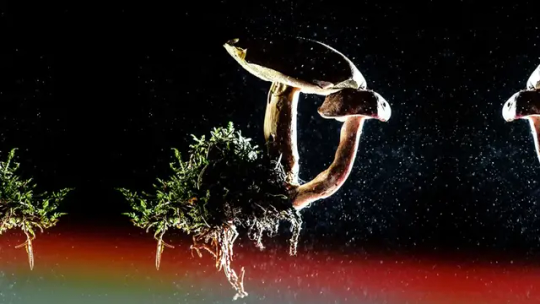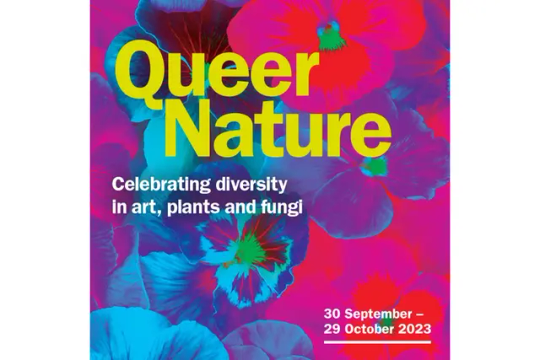#Symbiopoesis
Text

Queering the Wild by Micha Rahder (2019) [final]
Queer Intimacy in Non-Human Animals
The author introduces several examples of ‘queerness’ across the animal kingdom—the ‘birds and the bees’, --a lot about birds since we have a lot of research on them. The study on zebra finches reminded me of the concept of ‘naturecultures’; they choose their mates and often do not stray, same-sex or otherwise and so this supports the idea that there is more to ‘bird life than breeding and that the social aspects of bonding might be just as important’ (02).
“The idea that sexual activity might be about more than just making babies is hard for people who were raised in contemporary U.S. American culture in particular, with its focus on abstinence-only sex ed and heavy legislation of uteruses and the people who have them” (02) but finches, bonobos, dolphins or ‘female fish that prefer males that have had sex with other males, all chip away at that anthropocentric frame’ (02).
“Because scientists carry their cultural biases into their work, most research approaches these kinds of queer traits and behaviors as problems to be solved” (02). Heteronormativity has made scientists ‘run in circles’ trying to explain why such ‘maladaptive’, ‘perverted’ traits appear throughout the natural world such as nutritional deficiencies, the stress of captivity, that they’re just ‘dumb’ and can’t tell the difference, it’s a ‘misfire’ attempt at heterosexuality, or they’re just ‘practicing’.
“Evolutionary biologists need to think about same-sex sexual behavior in non-human animals as more than just a problem to be solved” and “same sex sexual behavior is both a trait that is potentially shaped by selection and a force that shapes selection on other traits” or they should “consider how same-sex sexual activities shape ongoing evolutionary processes” (03).

Extending Our Chosen Family
Evolution has no “direction or purpose” and humans are not “the representation of the ultimate expression of life on earth” (03). If we look at microbiology, we can see true diversity. “Only recently have scientists started to pay attention to how much [microbes exchanging DNA] might be driving evolution” (03). Fungi are also an incredible example of sexual diversity; with one species alone having more than 23,000 documented mating types (sexes) and individuals can physically ‘merge or separate in different environmental contexts’ making it difficult to differentiate them.
‘Symbiopoesis’ or “how organisms can be intimately involved in each other’s development” (squid and light emitting bacteria, bees and pollination, acacia trees and ants, wasps and figs).(03) Again this reminds me of the Lakota concept of Mitakuye Oyasin—we are all related, all my relatives.
Competition//Cooperation is another binary that queer ecology can challenge.
“Queering nature means learning about our connectedness with all the living earth. Here, the classic queer recognition of chosen family extends beyond humans, recognizing our kinship and interdependence with our companion animals, the foods we eat, our microbes and others. It means taking pleasure in those connections, learning to recognize pleasure in others and understanding how our human identities, gender expressions and sexual behaviors are only a small piece of the wide, queer living world” (04).
Queer ecology asks us to be curious about the ‘magnificent overabundance of reality’ (Bagemihl). “Breaking free from the historical biases of science allows us to move forward together with other life on earth, rather than thinking ourselves as separate from or above it. That kind of hierarchical thinking has kept queer and other marginalized communities away from the benefits of being outdoors and has led directly to the tangle of global environmental crises in which we find ourselves now. Learning from non-humans is a great way to undo these legacies” (04).

#queering the wild#queer ecology#queer nature#ecofeminism#heteronormativity#queer theory#critical ecology#environmental politics#ecology#queer history#mitakuye oyasin#evolution#naturecultures#Symbiopoesis
41 notes
·
View notes
Text

Mitákuye Oyás’iŋ. Tapestry Institute. https://tapestryinstitute.org/mitakuye-oyasin/. Referencing Sicungu Lakota Elder Albert White Hat.
Their website defines itself thusly: Tapestry Institute weaves Indigenous Knowledge to life through activities and publications that use Indigenous ways of knowing, learning about, and responding to the natural world. The particular post I am referencing is about the Lakota phrase ‘Mitakuye Oyasin’ (also spelled as Mitákuye Oyás’iŋ, mitákuye oyásʾį). “The Lakota phrase Mitákuye Oyás’iŋ describes Reality by addressing it as “All My Relations.” All humans, all animals, all plants, all the waters, the soil, the stones, the mountains, the grasslands, the winds, the clouds and storms, the sun and moon, stars and planets are our relations and are relations to one another. We are connected to each other in multiple and vital ways. When one is in pain, all are harmed. When there is justice for one, there is more justice for all.”
This quote is important as it confirms the idea that ‘Mitakyue Oyasin’ is more than merely a meaningful phrase, but is a way of describing Reality. It also helps describe the sheer scope of what the words mean. What is also important to recognize is the belief in pain and justice also being interconnected as this can be connected to feminist ideas expressed within much queer ecology. But, the post also emphasizes that even though ‘All our Relations’ is the most common translation of the words, “the phrase actually bears within it rich layers of additional meaning that cannot be easily translated into English. It’s important to point this out because words and ideas, stories and rituals, are bound together into a single reality that must be respected, not misappropriated”.
youtube
Finally, the video interview with Albert White Hat adds even more complexity: the wisdom in these words are not “merely a collection of historical ideas or words” but “ a system of powerful knowledge applicable to the lives and struggles of people right now”. This ultimately supports my thesis; that indigenous worldviews (in this case, Mitakuye Oyasin) can be in symbiosis/symbiopoesis with queer ecology--the concept is a tool (a much more besides) that can be applied to the struggle we face in healing our planet.
-- Symbiosis is any type of a close and long-term biological interaction between two biological organisms of different species
-- ‘Symbiopoesis’ or “how organisms can be intimately involved in each other’s development” (squid and light emitting bacteria, bees and pollination, acacia trees and ants, wasps and figs). (Rahder)
#queer ecology#tapestry institute#critical ecology#indigenous people#traditional ecological knowledge#mitakuye oyasin#symbiosis#symbiopoiesis#ecofeminism#queer theory#environmental politics#ecology#colonialism#Youtube
9 notes
·
View notes